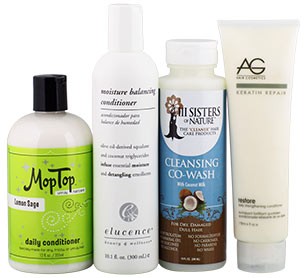

You can use a shower cap, plastic cap or even go old school and wrap it up in a little bun using a hair tie. It’s time to wrap up those gorgeous locks. It also takes care of any knots, tangles or sections that need to be brushed out. This detangles each section of hair and evenly distributes the deep conditioner over your hair. Grab a wide-toothed comb or brush made for curly hair, and comb out the hair from the base of the hair to the end, then twist each section, so it doesn’t get stuck to another area of hair. Always apply your product to completely wet hair so your hair can soak up all the goodness from a deep conditioner. Apply the conditioner from root to tip (don’t be stingy) and make sure the product covers your hair fully. Spread an ample amount of deep conditioner on your wet hair. With clean, freshly washed hair, start by parting your hair into different sections. Here are a few simple steps to follow to get the most out of your deep conditioner. Always read the directions on your deep conditioner, though while we recommend shampooing your hair, some deep conditioners state that you do not need a fully washed head of hair to use their product.
Best deep conditioner skin#
Clean your whole head of hair, ensuring it is free from dirt, grime and dead skin cells.
Best deep conditioner how to#
How to use a deep conditionerīefore using your glorious new deep conditioner, you’ll want to lather up and get those hair follicles clean. This product is always free from sulfates, parabens, mineral oil, gluten, dyes and phthalates, so you never have to worry about stressing out the hair with synthetic chemicals. Coconut oil, monoi oil and raw flower petals work deep into the hair to recover natural hair structure. Whichever method you choose, the powerful natural ingredients will restore shine, hydration and luster. Or you can leave it in your hair for an overnight treatment. The Deep Conditioning Protein Pack can hydrate hair once a week as a weekly deep conditioner after shampooing. Not sure where to start? We talked to hair stylists to round up the best deep conditioners out there.(Palmer's Coconut Oil Formula) | Deep Conditioning Protein Pack.Ĭoconut oil can do it all, including bringing ultimate hydration to stressed, broken and dry hair. You may also benefit from leave-in treatments, like conditioning sprays and moisturizing masks. Over-washing can lead to over-drying, repeating the cycle.Įxpand your horizons: Don’t just stick with traditional conditioners that wash out of hair.

“Applying it to the scalp can make hair ‘greasier’ faster, leading to over-washing,” she says. Hermann recommends focusing on ends only. Keep it to the ends: It’s logical to think that if you have dry hair, you should apply conditioner from root to end, but Dr. Other hydrating ingredients to scan for: Shea butter, jojoba, argan, and coconut oils, aloe vera, and glycerin. “Dimethicone decreases static electricity, increases shine, and enhances hair flexibility, making it easier to style,” says Dr. Look for dimethicone: This is one ingredient you don’t want to miss on the label. How to choose (and use) the best deep conditioner for your hair Lathering up a great shampoo can do wonders for your locks, but your conditioner will be the real MVP in bringing moisture back to your strands-enhancing softness and smoothness in the process. Your shower routine makes a difference, too. Your best bet to beat dry hair? Use styling tools infrequently, avoid dying it lighter than one shade lighter compared to your natural color, and wear a hat to protect strands from UV damage, Dr. “Over time, this can not only lead to severely dry and damaged hair, but also scarring and permanent hair loss.” And while processing treatments can make hair appear sleek, they actually “break chemical bonds in the hair when trying to ‘straighten’ it,” Dr. “Natural water in hair can turn to steam, creating bubbles in the hair shaft, which damages the cuticle, the outer protective coating that keeps hair strong and resilient,” she explains.Ĭhemicals can also damage this cuticle while simultaneously stripping your hair of natural oils that are crucial for hydration. Heat damages your hair because it cooks it, says Dr.

Think: certain hair dyes, overuse of clarifying shampoos, heat damage from blow-outs and styling, or over-processing with keratin treatments. The top culprits include heat and chemicals. While curly hair types are more susceptible to lack of moisture, “dry hair mostly results from lifestyle factors,” says Jennifer Herrmann, MD, a board-certified dermatologist in Beverly Hills. And if those are the problems you’re dealing with, your real issue may be dry hair.
Best deep conditioner full#
But in reality, sometimes it’s more straw-like, scorched, or full of frizz. In an ideal world, we all have shampoo commercial-worthy hair.


 0 kommentar(er)
0 kommentar(er)
